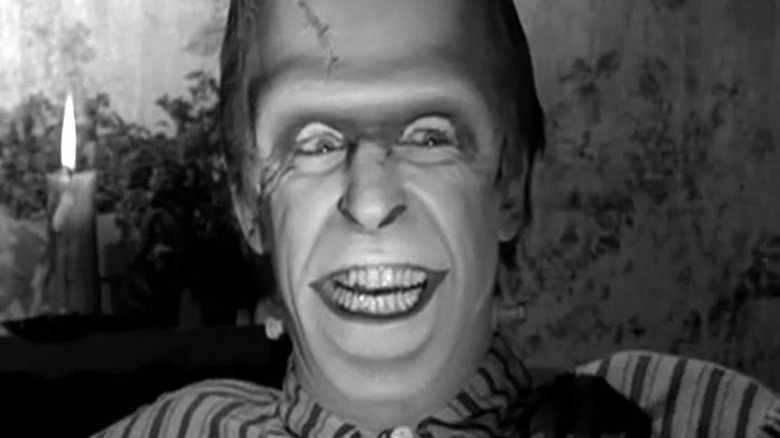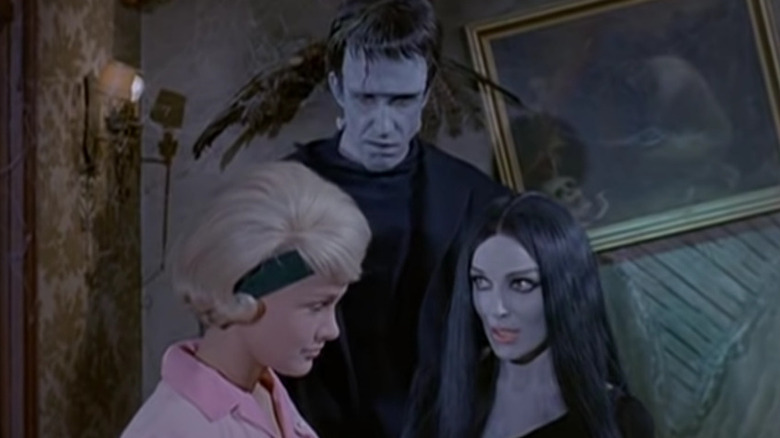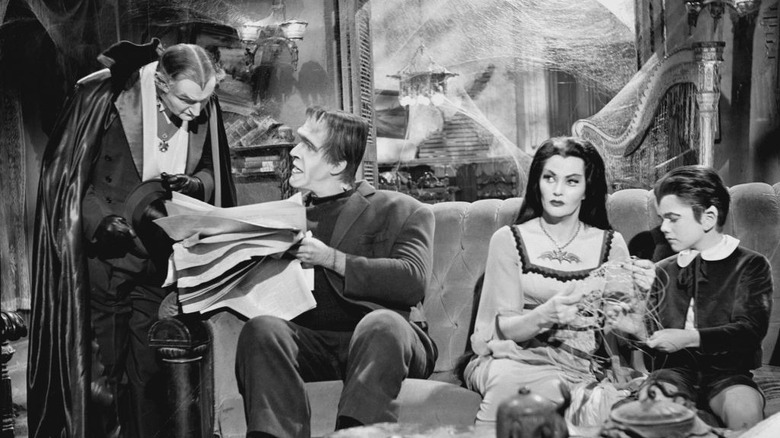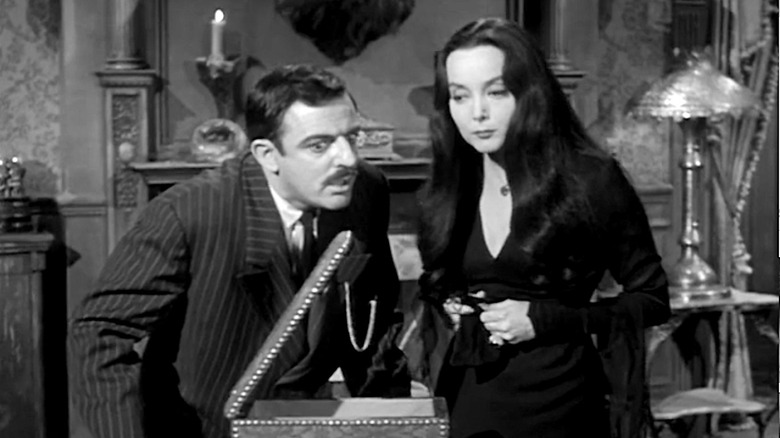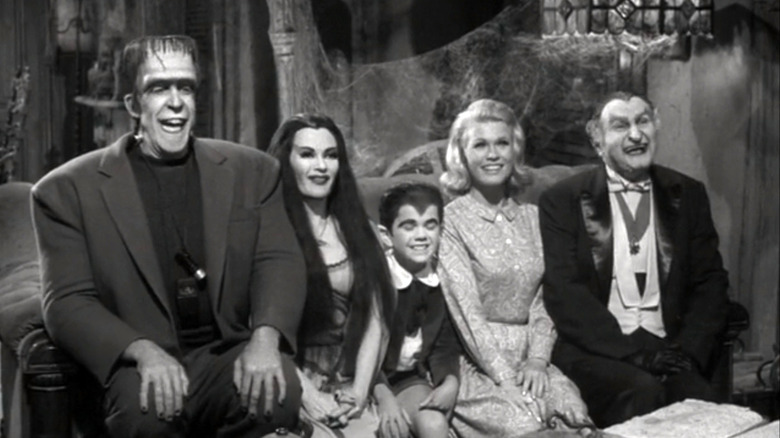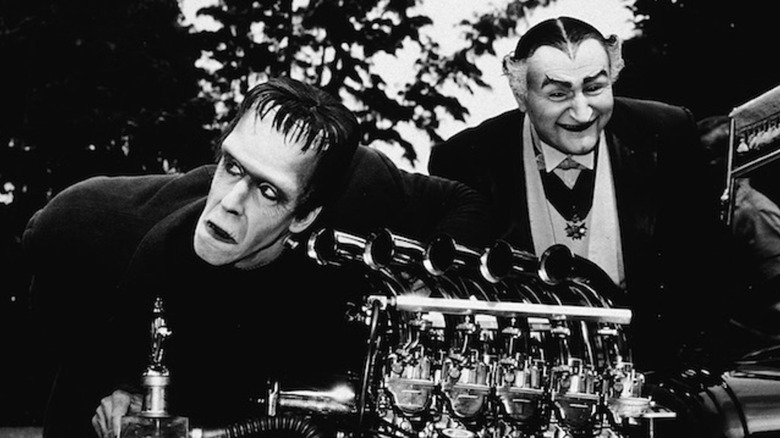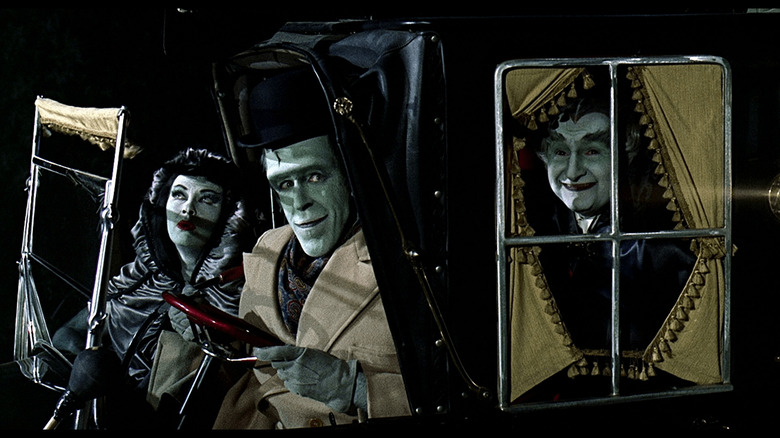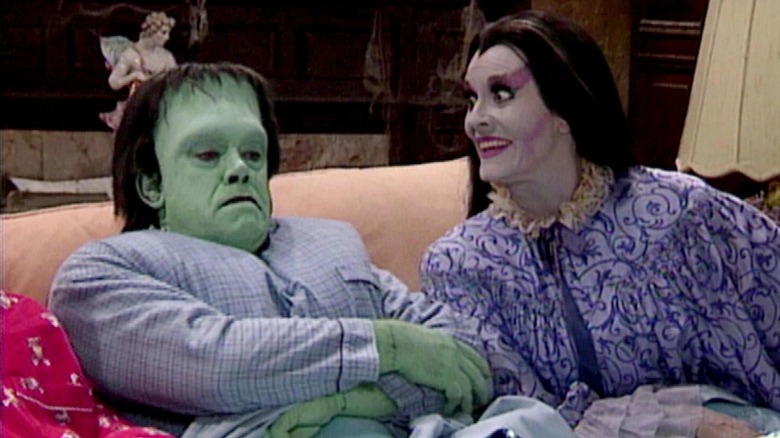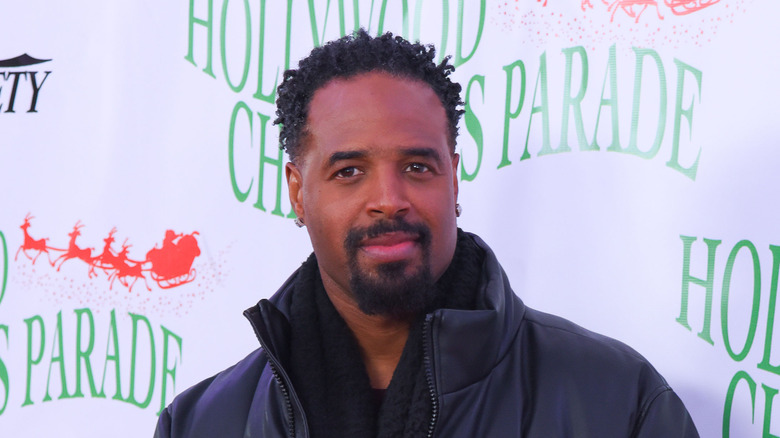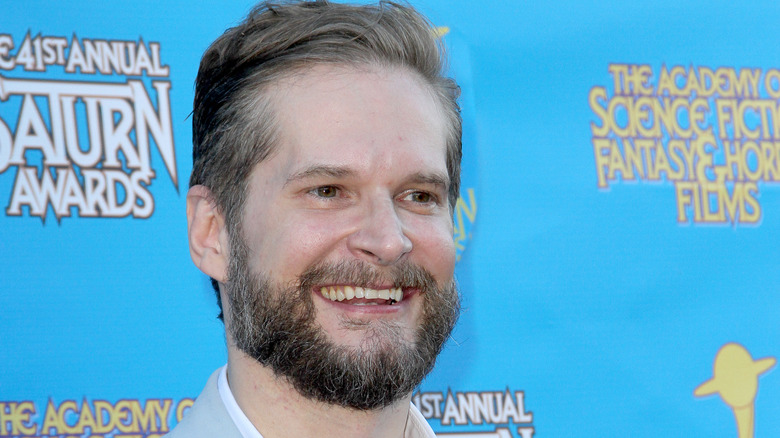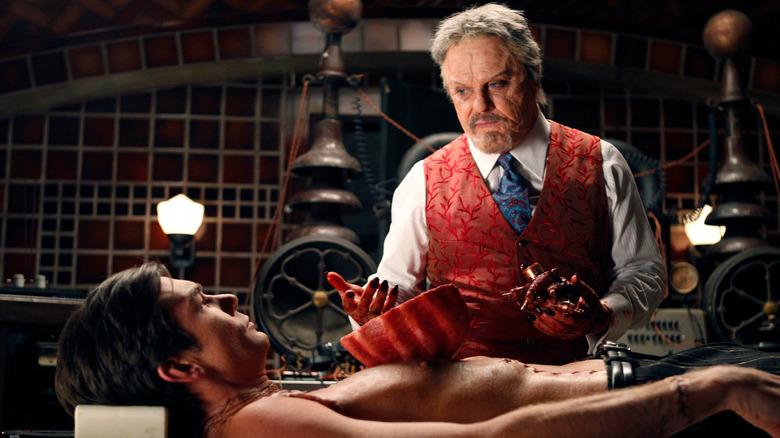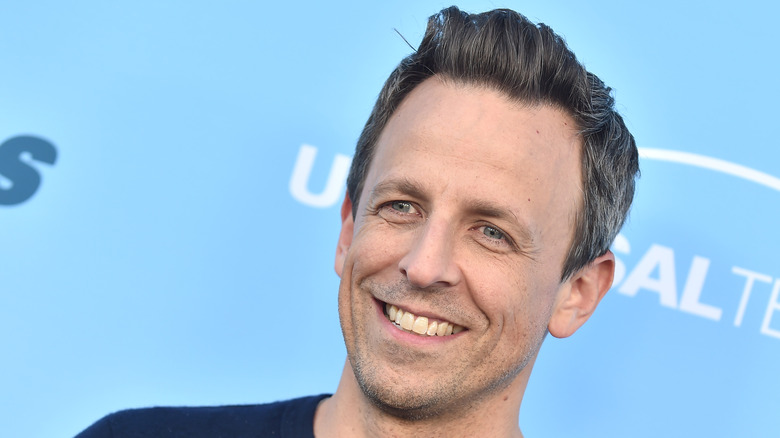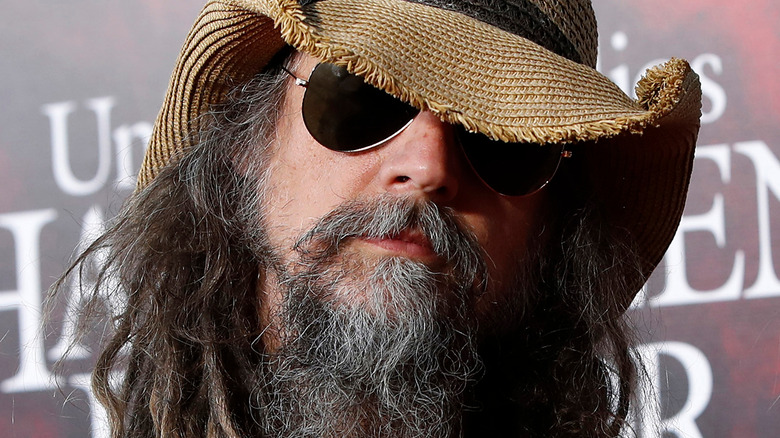The Untold Truth Of The Munsters
Family can be just as scary as any movie monster. Such a universal truism helps explain why the central concept of "The Munsters," a 1960s TV program chronicling the exploits of a family whose individual members largely looked like movie monsters, resonated so deeply with general audiences. This story was enough to sustain not only an original TV show but an ongoing media franchise that's encompassed everything from merchandise to movies to even further TV shows following up on the exploits of the Munsters family, decades after the original show ended. It can be outright frightening to consider just how enduringly popular "The Munsters" is as a pop culture property.
But though "The Munsters" continues to be beloved by the general public, there remains an untold truth of this franchise, which includes everything from behind-the-scenes facts about the original series to various abandoned attempts to revive the property for the 21st century. Even if you feel like you know "The Munsters" well enough that Eddie Munster feels like your own sibling, the untold truth of "The Munsters" will still provide you with plenty of unexpected delights.
The original Munsters pilot was filmed in color
Like many TV shows of the 1960s, "The Munsters" aired in black and white. However, as noted by outlets like Do You Remember, the show's original unaired pilot was shot in color, which would have made the distinct vibrant hues of the different family members more apparent. However, a decision was made between the filming of the pilot and the eventual premiere of the series that resulted in the rest of "The Munsters" being filmed in a monochromatic hue. This turned into a memorable visual facet of the show, but it's still one wrapped in mystery.
No definitive reason has ever been given for why "The Munsters" was not filmed in color after the pilot. Among the speculated reasons are that it was done to save money and make it look more like the classic Universal monster movies of the past. Whatever the reason, "The Munsters" being broadcast as a black and white show certainly proved to be a memorable part of the production, even if it left some visual facets of the program, like the makeup effects, harder to appreciate.
Where The Munsters was filmed
The iconic home of "The Munsters" at 1313 Mockingbird Lane was not just filmed anywhere. Keeping with the Universal Monsters theme, exterior shots were filmed on Stage 12 of the Universal Hollywood backlot, while Stages 30 and 32 were used for interior shots. According to The Studio Tour, the project utilized a house that had originally been built for the 1946 movie "So Goes My Love." It was also used for a handful of other TV shows, including "Wagon Train" and "Leave It To Beaver," before getting its most famous use as the domicile of "The Munsters."
This iconic home was once again employed for feature films like "Munsters Go Home!" and "The Munsters' Revenge." However, the original house used for "The Munsters" couldn't last forever. It was eventually overhauled and used as a central home for the TV show "Desperate Housewives." 21st century takes on the characters, such as the TV pilot "Mockingbird Lane" and the Rob Zombie "Munsters" movie, have taken to filming in drastically different locales than this backlot. However, the past of "The Munsters" will always be rooted in this location.
The Munsters - Addams Family 'rivalry'
Among many similarities between the two properties, "The Munsters" and "The Addams Family" have their roots in pop culture dating back years earlier. "The Munsters" was inspired by classic Universal monsters of the 1930s and 1940s, while "The Addams Family" was originally a series of New Yorker cartoons from Charles Addams. However, the most famous iterations of both properties were 1960s prime time TV shows that went head-to-head, giving birth to a "rivalry" between the two "spooky family" programs.
"The Addams Family" technically made it to air first, with its initial episode airing just six days before the the inaugural installment of "The Munsters." Though it was the runner-up in getting on the airwaves, "Munsters" would technically last a smidge longer, having aired 70 episodes versus the 64 episodes of "The Addams Family." In the end, "The Addams Family" would end up having a larger pop culture presence than "The Munsters," thanks to a series of successful theatrical movies and a Broadway musical. But even today, comparisons abound between these two TV shows that dared to imagine what a more unusual form of the American nuclear family would look like.
Why The Munsters was canceled
Given just how ubiquitous the characters of "The Munsters" continue to be in pop culture, it can be puzzling to contemplate that the show was canceled in May 1966 after just two seasons.
"I think 'Batman' was to blame," cast member Butch Patrick (Eddie Munster) told Fox News. "'Batman' just came along and took our ratings away." The power of Adam West's Batman may have brought "The Munsters" to a close, but there wasn't any resentment over saying goodbye to these characters. "Look, we had a good two-year run putting out something that was so different and unlikely to become a success," Patrick explained. "So we felt it was the right time to go. Fred [Gwynne] and Al [Lewis] were also ready to go home. We were OK with it."
Meanwhile, KXRB writer Randy McDaniel noted that another reason for "The Munsters" getting yanked off the air was that shows broadcast in color were becoming more and more popular by the mid-1960s. A black and white TV show like "The Munsters" just couldn't compete. While this put an end to the very first incarnation of the characters, "The Munsters" as a franchise would continue to live on for decades to come.
The Munsters thrived in syndication
In the modern pop culture landscape, streaming is the key to the longevity of a TV show. A program like "The Office" or "Manifest" can take on a whole new life thanks to how many people watch it on Peacock or Netflix, respectively. But not so long ago, it was the practice of syndication that determined how long a TV show would go on once it stopped producing new episodes. Reruns on various channels were critical to many TV shows, including "The Munsters."
Deadline recently noted that "The Munsters" was not a monster smash in the ratings when it first aired on television. However, the outlet observed that it was on syndication where "The Munsters" gained a second wind that ensured it would stick around in the pop culture consciousness. Reruns of old episodes proved so popular that they inspired a series of TV specials, a revival of "The Munsters" in the 1980s, and several attempts at translating "The Munsters" into a theatrical movie. All these developments serve as evidence of the power syndication used to have over determining a TV show's long-term fate with viewers.
The Munsters go to the movies
Just because "The Munsters" went off the air after two seasons didn't mean the characters would be staying away for long. Like other popular TV shows of the 1960s such as "The Flintstones," "The Munsters" eventually made their way to the big screen in "Munster, Go Home!" Though it did get a theatrical release, its impact on the box office was so minimal that there is no recorded box office receipts for the project. However, this film did establish the Munsters as capable of headlining feature-length projects, even if, as pointed out by Matt Brunson of Film Frenzy, "Munster, Go Home!" often played "like an extended episode of the series, even with unintentional pauses where the studio audience laughter usually filled the air."
The feature-length exploits of this TV family would not end with "Munster, Go Home!" The original cast would return for another longform adventure in "The Munsters' Revenge" in 1976. In a departure from its predecessor, this one went straight to television rather than debuting in theaters. In the decades that followed, new iterations of "The Munsters" would return to feature-length storytelling through TV movies like "Here Comes the Munsters." Though none of them, even the original "Munster, Go Home!," garnered as much pop culture notoriety as the original "Munsters" show, these movies did make a case for "The Munsters" not being flash in the pan pop-culture sensations.
The Munsters Today brought them into the 1980s
After two decades off the air, the Munsters returned to delivering new episodes of television in 1988 with "The Munsters Today." Following the characters after they emerge from two decades of accidental cryogenic sleep, the program followed the familiar members of the Munsters clan as they adjusted to a new decade.
"When you're dealing with the Munsters, the only unique thing is themselves,” executive producer Arthur Annecherico told the Chicago Tribune about "The Munsters Today" and how its tone would compare to the original show. ”They'll face different problems, and it will be a little more modern, but we treat them like any other sitcom family on the air. It's mom and dad and a couple of kids with all the problems they have around the house. So what if you're looking at Frankenstein and Dracula?” Though not as big a hit as the original show, "The Munsters Today" still managed to run for a respectable 73-episode run over three seasons, further demonstrating the longevity of these eerie characters.
The unmade Wayans Brothers Munsters movie
In the early 2000s, every old TV show with a recognizable brand name was getting a feature film adaptation. Everything from "Charlie's Angels" to "The Honeymooners" to "Bewitched" was being translated to the silver screen. It's no surprise, then, that "The Munsters" were also, at one point, set to join in on this trend. The property was planned to be adapted into a big-screen comedy handled by the Wayans Brothers, who were hot off hits like the original "Scary Movie" and "White Chicks."
First announced in the summer of 2004 , the project was tinkered with for years, though Shawn Wayans offered a major update on he project in November 2008. In addition to announcing that this new "Munsters" movie was preparing to finally begin filming, he also noted that he and Marlon Wayans would not appear in the films. "If we do anything, maybe we'll do a cameo, but we're not gonna make The Munsters black all of a sudden," Wayans noted. "[The Munsters are] gonna be green, white people just like they were in the TV show. Their characters are still who they were in the '50s. It's just in modern day." Despite these notable developments, this "Munsters" movie faded out, perhaps because the trend of big-budget movie adaptations of classic TV shows had also died off by the end of the decade.
Bryan Fuller revamped The Munsters with Mockingbird Lane
If you're going to do a new take on "The Munsters," you can't just do a rehash of the old TV show. You need to make something as distinct and unique in the modern pop culture landscape as the original "Munsters" was when it first took to the airwaves. In prepping his reboot of the "Munsters," titled "Mockingbird Lane," Bryan Fuller, the man behind TV shows like "Pushing Daisies" and "Hannibal," was well aware of this fact and carried several specific ideas on how to revamp "The Munsters" for 21st century viewers.
"The Munsters actually do what monsters do: they eat people and they have to live with the ramifications of being monstrous," Fuller said to The Hollywood Reporter about his creative vision. "It's like grounding it in a reality because the half-hour was a sitcom, we saw the monsters: they were monsters on the outside and weren't monsters on the inside. For us, they're monsters outside and inside, and we get to double our story. So any story you can tell on 'Parenthood' and 'True Blood,' we can tell." That kind of bold tone isn't quite what one would expect from a classic "Munsters" episode, but it's just the sort of mixture one would want from a modern update of the property.
Why Mockingbird Lane never became a TV series
The entertainment industry's love for familiar brands and reboots made it seem like "Mockingbird Lane" and its modern take on the Munsters would be a shoo-in to get picked up for a series, especially since it was being handled by acclaimed creator Bryan Fuller. However, the show failed to go beyond a pilot, which aired as a TV movie on Halloween 2012. Despite all the positive elements that were working in the show's favor, though, it turned out there were issues with the pilot that held it back.
"We just decided that it didn't hold together well enough to yield a series," former NBC head Bob Greenblatt told Deadline. "It looked beautiful and original and creative, but it just all ultimately didn't come together ... it just didn't ultimately creatively all work. We felt great about the cast. But we tried to make it not just a sitcom. We tried to make it an hour, which ultimately has more dramatic weight than a half-hour. It's hard to calibrate how much weirdness vs. supernatural vs. family story. I just think we didn't get the mix right." Even in an industry that loves to milk familiar brands for all they're worth, those issues were just too troublesome to make "Mockingbird Lane" an ongoing series.
Seth Meyers almost oversaw a Munsters reboot
In his time as a cast member of "Saturday Night Live" and the host of "The Late Show" on NBC, Seth Meyers has proven to be a valuable member of the NBC Universal media team. It shouldn't be a surprise, then, that at one point Meyers was angling to give an overhaul to one of the company's most valuable nostalgic properties with NBC a revamp of "The Munsters."
Deadline reported in 2017 that Meyers was teaming up with Jill Kargman to spearhead this half-hour comedy project, which would reimagine the titular family as denizens of hipster Brooklyn. Despite having both Meyers and a concrete vision for how to make this incarnation different from past iterations of the property, no further updates emerged for this version of "The Munsters." The lack of any other developments made it impossible to know for certain why NBC abandoned the project, although after "Mockingbird Lane" failed to launch, it appeared as if executives were being cautious with the brand. This attempt at reviving "The Munsters" didn't just disappoint fans of the franchise, it also provided the rare instance of a Seth Meyers production going nowhere in his longstanding creative relationship with NBC/Universal.
Rob Zombie's love for the Munsters leads to new reboot
Rob Zombie's directorial efforts have largely been grim horror movies full of gore and raw violence. "House of 1000 Corpses" or his two "Halloween" movies spared viewers no details in depicting graphic, horrifying brutality. He's not exactly the go-to guy one would think of to handle a new version of the decidedly family-friendly "Munsters" property. But that's just what happened when Universal tasked Zombie with directing a new feature film starring these spooky characters.
Rather than being just a gig-for-hire job for Zombie, this was a passion project based on his longstanding love for the characters. "Attention Boils and Ghouls! The rumors are true!" Zombie wrote on Instagram announcing the movie. "My next film project will be the one I've been chasing for 20 years! THE MUNSTERS!" The mention of him harboring a love for "The Munsters" was no PR hyperbole. As pointed out by Bleeding Cool, Zombie has often utilized imagery from the original "Munsters" TV show in his concerts and videos, owns a number of original props from the series, and even provided an audio commentary for a home video release of "Munster, Go Home!" With all these connections to the franchise, Zombie suddenly seems like a much more understandable pick to helm a "Munsters" movie.
